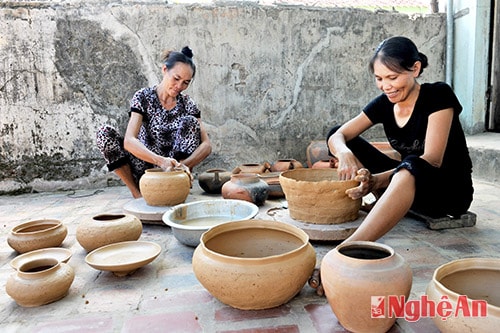Braised fish in clay pot
(Baonghean)- In a conversation with Mr. Tran Ba Luan, the owner of the famous fish stew kiln in Vu Dai village (Dai Hoang village - Hoa Hau commune, Ly Nhan district, Nam Ha province), he shared: "Nghe An soil is smooth, rich, the product is beautiful, can withstand the heat of the hot fire. If you knock on the pot with your hand and hear a clinking sound, it means the pot can withstand the heat of this fish stew profession!". He said: One day with a backpack on his shoulder, he boarded the train to Cau Giat station - Hanoi, pushing his companion a bicycle, two baskets full of clay pots. Once on the train, the pot driver was still excited to take out a finger-sized bamboo stick and knock on the pot, making a joyful sound, humming along to the song "I'm angry, but I love...". And from that chance, after the day my village re-established the traditional fish stew profession, I took the trouble to go all the way to Cau Giat station to find the Tru Son pot village (Do Luong) to place an order.
 |
| Making clay pots. Photo: Sy Minh |
In the past, the pot drivers were farmers who had free time to go to the market and often bought two big bamboo baskets. Or if they had one, they would buy a dilapidated bicycle to arrange goods at Bong market or Veo market. Then they would form associations and join wandering groups to distribute products throughout the North Central region. Some people even got on the train to travel from the South to the North with a long handcart, a small bag containing some dry food such as rice, salt, fish, and fish sauce. Wherever they went, they would use stones to cook and finish their meal at noon. Thinking back, what was deeply imprinted in their memories! The old farmers, their bare red shoulders weighed down with the heavy load of earthen pots, could not sell them all at the market, so they carried their loads to the villages to exchange for corn and rice with heartbreaking cries. Looking at them, one felt sorry for the pot sellers, their wet oak shirts and handkerchiefs stained with porridge because of the wind and rain.
In recent years, the economy has developed at the speed of industrialization, and metal and electrical goods serving meals are more diverse and convenient. Now, few people cook rice with wood stoves anymore. Palm and paper fans are also covered by the dust of time. If we do not know how to appreciate the old things, and do not change the "mechanism" to integrate slowly, they will surely be "terminated". But the paper fan and pot making villages of Tru Son still live. Because of the dynamism of people who love their homeland, their fatherland, and their ancestors, such as Mr. Tran Ba Luan and his son in Vu Dai village, and Mr. Nguyen Huu Tao in Tru Son (Do Luong). The two craft villages are randomly linked together by two traditional crafts but are completely different in style and characteristics of production.
After Tet, the whole Vu Dai village was red-hot day and night braising fish batches to release to domestic and foreign markets, such as Japan, Korea, China, countries with the same Eastern culinary culture. The product was "braised" for up to 24 hours, stewed like banh chung but with moderate heat to prevent the "juice" from overflowing, to meet export standards. Currently, Mr. Luan's son is studying in Hanoi, but is fascinated with his hometown's braised fish, and is fascinated with the traditional craft that is as famous as the name of his village, which was made famous thanks to Nam Cao "accidentally" promoting the name of the village, through the famous short story "Chi Pheo", he set up a marketing website for his family's and neighbors' brands to elevate the brand. According to family experience, cooking anything in a pot, kettle, pan, or clay pot will make the rice delicious, the soup sweet, and the fish and meat rich; and traditional medicine boiled in a clay pot will retain the flavor and nutrients in the medicine. The two craft villages have found each other, connected by their livelihoods, and also preserved the beauty of the rural countryside.
Vu Dai village braised fish is exported thanks to Tru Son village's clay pots for packaging with beautiful designs, contributing to the brand "Vu Dai braised fish in clay pots". That is also the reputation of the most arduous and tumultuous clay pot profession in Nghe An. The clanging sound of the clay pot seems to permeate our minds, reminding us not to forget the old. Don't lose the long-standing traditional values that are not easy to achieve in a day or two.
Nguyen Viet Loi
(85 Dao Tan - Vinh)
